Nitrite can cause significant damage to aquatic inhabitants or even kill them.

So how do you protect them if an imbalance occurs?
Why is it that with goldfish nitrite levels can spike more often?
How to reduce said levels on time, without suffering fish losses?
Essentially, you should change some of the water to offset potential damage and then introduce beneficial bacteria in some form to help convert the Nitrite into Nitrate.
But is there also a silver bullet nitrite remover that can take care of the mess?
Let’s dive right in.
- Organic matter degrades to ammonia (NH3).
- Bacteria convert that ammonia to nitrites (NO2-).
- Other bacteria transform the nitrites in nitrates (NO3-).
With that out of the way, we can answer the important questions.
How to promptly lower the nitrite levels in your freshwater aquarium?
Nitrites are the second most toxic byproduct in the nitrogen cycle of an aquarium.
They can be lethal to most freshwater fish if not handled on time. To promptly lower the high nitrite levels in your freshwater aquarium follow these exact steps:
1. Change 30% of the water.
With this initial step, you aim to replace part of the nitrite-rich water and dilute the harmful compound in the tank.
By physically diluting the concentration you will ease the negative effects on your livestock.
I recommend splitting the 30% into two partial water changes of 15% and performing them 1 to 2 hours apart. This way you’ll make sure that the drastic shift in parameters that comes after a larger water change won’t finish off your fish.
Fish can adapt to gradual changes in their environment, including an increase in nitrites.
However, by performing a large water change you significantly alter the water chemistry in a short matter of time.
This can send you fish into an osmotic shock, which is the last thing your fishpals need.
Author’s note: Water changes can also help with reducing high Ammonia levels in your fish tank.
2. Add nitrifying bacteria
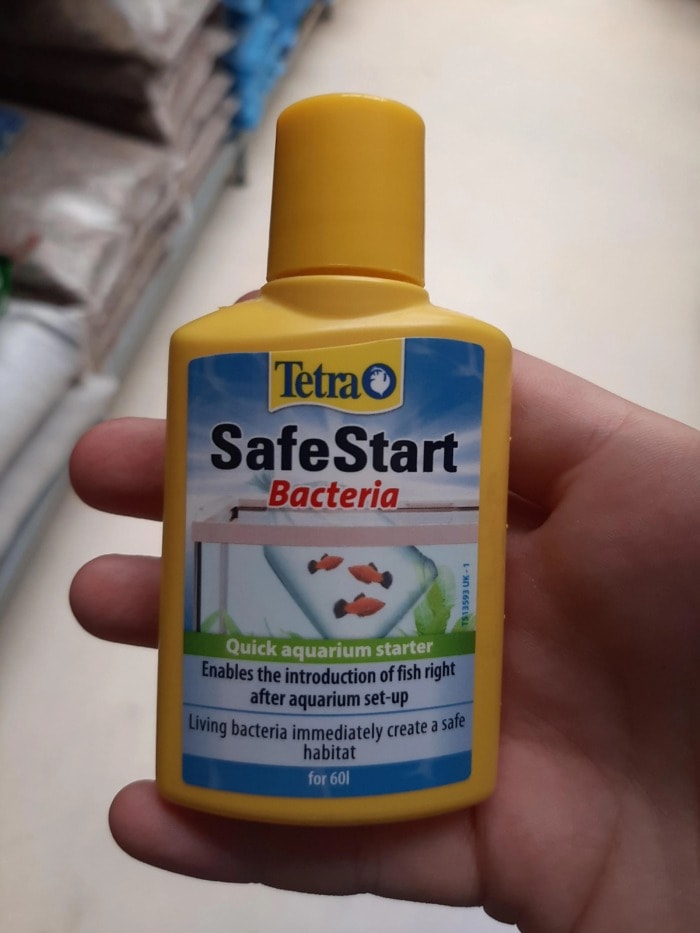
by flexed_guitar
Since high nitrite levels are signaling an incomplete nitrogen cycle, adding some good bacteria to the system should be your second course of action.
One of the most efficient ways to quickly add beneficial bacteria to your tank is by using bottled bacteria. There are many bottled bacteria products on the market.
Most of them are complete garbage, however, the reason being the use of cheap-grown land-based nitrifying bacteria.
These land-based organisms will essentially outcompete the not-well-established aquatic bacteria and then die out in underwater conditions.
And then you’ll be left with another spike in nitrites and no one to handle that. Luckily, after conducting my own experiments, I found four sound products that do actually work as marketed.
I also did a detailed comparison between two of them here, and namely Tetra SafeStart and API Quick Start. In the link, I also include the correct ways to use them.
For the purpose of controlling nitrites, I strongly recommend using Tetra’s SafeStart Plus.
From what I’ve found, it arguably has more nitrite-converting bacteria than API’s Quick Start product.
Look it up online (you can check it out here, on Amazon) or rush to your local fish store and buy it, as soon as you have the chance. If you do end up in the fish store make sure to get a bottle that’s as manufactured as recently as possible.
Amazon supplies are usually fresh, but in some cases, you may get lucky in your LFS as well.
Dose accordingly, but in my experience, you should pour the whole bottle in anything larger than 30 gallons.
It is beneficial bacteria and it won’t do harm to your fish.
I’m sure you already figured that but here it is anyway- supply yourself with the bacteria first, so you can add it immediately after the initial water change from step number one.
Avoid changing the water for the next couple of days to let the bacteria establish themselves.
The only time you should change water is if there’s a following inexplicable spike in Nitrite.
Though Seachem is a reputable brand in the hobby, they refuse to name the bacteria used in their product.
This is what stopped me from even bothering to test it, and therefore I can’t really recommend using it.
3. Set up a filter if you haven’t already

by GandolfBesh
The media in our aquarium filters is where most beneficial bacteria live.
By setting up a filter you will do two things – improve the oxygen levels in the water and provide a living place for the new bacteria.
The first will help your present fish to cope with the lower oxygen levels in their blood, caused by the potential nitrite intoxication.
If you happen to have another established tank around you’re in luck.
Use SOME of its biological filter media in your nitrite-rich tank.
There you’ll have an already thriving bacterial colony that could immensely speed up the cycling process in the problematic fish tank.
Don’t borrow too much.
I’d recommend no more than 30% of the total biological media.
Aquarium filters are an invaluable piece of equipment when it comes to maintaining stable water parameters.
Even though you can harbor live fish without one, doing so is extremely difficult and requires advanced fish keeping knowledge.
So do your fish and yourself a favor, and don’t skimp on the aquarium filter.
Smaller aquariums can do with a simple HOB or sponge filter which barely cost a thing.
Note: For larger aquariums, perhaps, a smart decision would be to set a canister filter, as they have way more space for filter media and provide a very decent water turnover.
4. Add substrate from an established aquarium
The logic behind this is pretty much the same as in the previous step.
Bacteria also inhabit the substrate of your aquarium.
By adding some substrate from an established aquarium to your affected one you improve the bacteria’s numbers.
I’m emphasizing some, as you don’t want to inflict the same pain to your other fish.
A few scoops should be able to aid you in the battle against nitrite.
5. Hook up your filter to an already established tank
If by chance, you have another up-and-running aquarium, you can connect your filter to it and let it run for a week.
This will let the bacteria from your old aquarium colonize the media in your new filter.
Afterwards, all you need to do is install the filter into the new tank and wait until the nitrite levels drop.
Needless to say, you shouldn’t remove the filter from your already established aquarium if you’re going to attempt this. Doing so will remove all of the beneficial bacteria from it and ruin the nitrogen cycle.
Another thing I should point out is that this method will only work if you’re setting up a new aquarium.
If you’re dealing with a nitrite spike in an established aquarium, you should skip it.
How to (and should you) reduce nitrites in a saltwater fish tank?
In saltwater fish species nitrite is not toxic at all, or at least not notably toxic.
In freshwater aquariums, nitrite can be absurdly toxic to the fauna.
This is because it blocks oxygen uptake by binding to hemoglobin and transforming it into methaemoglobin.
Chlorides, however, prevent this by inhibiting the uptake of nitrite from the water.
And since the chlorides in freshwater aren’t enough, there’s nothing to stop nitrite from entering a fish’s bloodstream.
In some cases of elevated nitrite, this leads to chloride depletion in a fish’s body.
After nitrites enter a fish’s system, the balance of a number of biological mechanisms gets disturbed.
However, when salt is present in the water the chloride levels skyrocket.
That’s because the salts in saltwater contain chloride as is seen from their chemical formula, which is NaCl (Sodium + Chloride).
At chloride levels of 1.94% (or ~19,350 ppm) the nitrites can not outcompete them and poison a fish.
In some cases, a freshwater fish specimen will be a THOUSAND times more sensitive to nitrite than a saltwater fish.
The sensitive freshwater species are usually the ones that have adapted to living in soft water.
See, I’m not a chemist, but I do read a lot, to ensure the safety of my fish. I learned all of that from this guy, who’s a doctor and knows what he’s talking about.
If for some godawful reason you managed to raise them that much you should introduce nitrifying bacteria to the tank:
BIO-Spira and API Quick Start are very useful here.
Tetra SafeStart Plus is designed for freshwater aquariums by definition and won’t be of use for a marine tank.
Anyway, either BIO-Spira or API’s Quick Start will speed up the nitrogen cycling.
Still, if the nitrites are this high, there’s probably something large that is rotting or you just threw out too much filter media or substrate and decor.
Signs of nitrite poisoning going on in the aquarium?
Sometimes you can spot the symptoms of nitrite poisoning without a test kit.
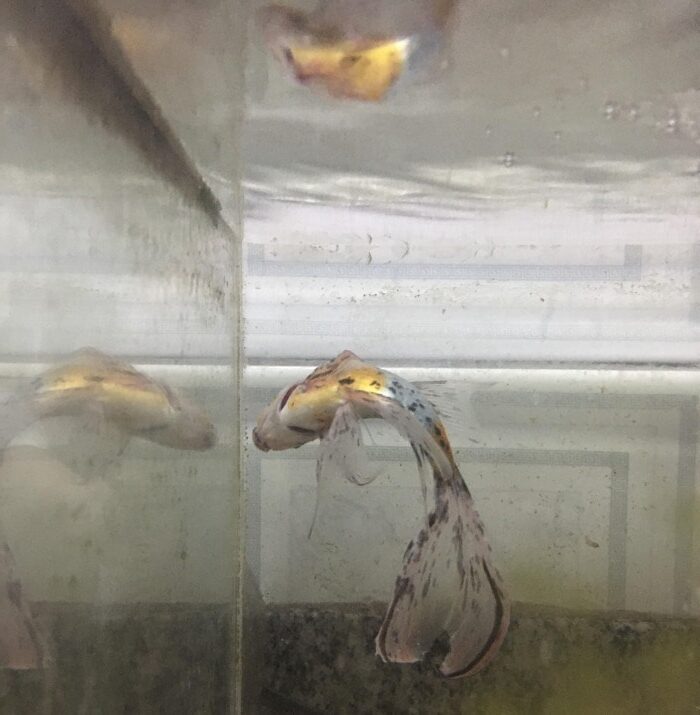
by Trickshroom
Affected fish can show clear symptoms identifying the presence of nitrites.
The signs in fish behavior that signal high aquarium nitrites are the following:
- darkened coloration of the gills;
- lethargic fish that are otherwise active;
- the death of an otherwise healthy fish;
- fish are gasping, with fast movements of the gills;
- constant striving to stay near the water surface.
How to protect your freshwater fish from nitrite intoxication?
The owners of freshwater aquariums should be concerned with their fishes’ health during elevated nitrite levels.
To protect your freshwater fish from nitrite poisoning you should:
- Relocate the fish to an established tank.
This is quite obvious, but some fishkeepers may underestimate the toxicity of nitrite.
Relocating your pet fish is your best bet to ensure their safety and prevent mortalities.
However, I’m assuming that most of you that read this don’t really have an established tank laying around.
Either this or it is full of large predatory fish that won’t really get along with the newcomers. In that case…
- Add rock salt to the water. By adding rock salt to the aquarium you enhance the present levels of chloride.
The elevated chloride will prevent the nitrites from entering your fishes’ body through the gills.
This will make them significantly more tolerant of the toxic compound.
Add 1 teaspoon of non-iodized salt per 10 gallons of water.
However, do your research on your fish before that. Most all scaleless fish (corydoras, loaches, some other catfish), tetra species, most invertebrates, and aquatic plants are very salt-sensitive.
You can use Aquarium-grade salt as well if you have that around.
I do not recommend buying it for the sole purpose of treating nitrite poisoning as it is just overpriced regular rock salt.
Kosher salt, however, is a sound choice.
- Add an air-stone.
After the nitrites enter your fish’s bloodstream they bind to the hemoglobin, oxidizing it to methemoglobin.
The latter does not carry oxygen, which can result in suffocating fish.
This is often called Brown Blood disease.
By adding an air-stone to your aquarium you aim at providing more oxygen to support the already O2-deprived fish.
Prime is a binder. It binds to the nitrites, converting them to other harmless molecules, and the process is labeled as “detoxifying”.
So far, so good, right?
Well, not exactly.
If the bacteria fail to transform all the detoxified nitrites while the effect of Prime lasts they may become overwhelmed when the binder’s effect expires in 24 hours or so.
Another thing to consider is that if you’re using tap water for your freshwater aquarium it will most likely be disinfected through Chloramine instead of Chlorine by your water facility. Chloramine is actually chlorine + ammonia. Seachem Prime removes the chlorine and detoxifies the ammonia.
But that’s actually extra ammonia released in the aquarium by the chemical bond of the two after Prime’s effect expires.
And that’s extra amount converted to nitrite after…
After 48 hours of a nitrite-free aquarium, you will be at your starting point.
This puts many inexperienced fishkeepers in the situation where they continuously use Prime ($$$), claiming it helps the nitrogen cycle.
This is simply wrong and a waste of money.
It is the tank’s bacteria that should be able to handle all the ammonia and nitrite and not external supplements.
High nitrite readings, but 0 ammonia?
The explanation behind this is very simple:
Whenever your aquarium has high levels of nitrites but no present ammonia, it means that it is halfway through its nitrogen cycle. Essentially, the ammonia-converting bacteria have established themselves, while the nitrite-oxidizing colonies are still insufficient in numbers.
If your tank is brand new – this is not the time to add fish, unless you introduce beneficial bacteria in some way. In fact, this is a common vicious cycle where an aquarist would keep seeing their fish die one after the other in their new tank and have no idea why.
Under normal circumstances, the nitrites should get converted to nitrates in 2 to 6 weeks. However, if the water temperature is below 70°F, it will take longer than that. Conversely, if your tank has been established for a while and this happens – something hindered its nitrogen cycle by releasing too many organics into the water.
Acceptable level of nitrites in an aquarium?
It is “acceptable” that we’re discussing here, so depending on your setup and fish species the answer can vary.
However, there’s a universally safe nitrite reading for any aquarium out there:
Generally, the safe level of nitrites in an aquarium is considered to be between 0 and 0.2 ppm (ml/g).
Bear in mind that some species of fish are more nitrite-tolerant than others.
What causes the progressive intoxication is the rapid ingestion of the poison (actually aiming for chlorides) through the gills.
Some fish species do not take up chloride from their gills, which makes them more tolerant to a nitrite spike.
On the other hand, some species of catfish, the fathead minnow, the roach, and the tench fish may be able to withstand a reading of more than 4 ppm.
For saltwater fish, the lower barrier will be as much as 30 ppm of nitrite.
This is quite a lot and, honestly, very unlikely scenario in a home aquarium.
The honorable mention goes to the common eel, which can live comfortably for as much as 4 days in water that has over 1600 ppm of nitrites.
Impressive stuff.
How you got high nitrites in the first place?

Obviously, something lies behind all of this. Well, let me guess.
The significant spike in nitrite levels in the aquarium appeared after:
- You recently added too many fish at once;
- You recently started the aquarium (less than a month and a half ago);
- You did a full clean of the filters and substrate or changed them;
- You have a heavily planted tank but forgot to prune and remove dead leaves lately;
- One of your fish has recently died but you did not immediately remove its body;
- You feed your fish more than twice a day;
- You treated the water with an antibiotic without removing the biological filter first;
- You put ice in the water in an attempt to cool it on a hot summer day;
- You didn’t dechlorinate before a water change;
- You have an overall small fish tank (under 10 gallons).
What all of these have in common is the imbalance between the levels of produced nitrites and the numbers of beneficial bacteria that convert them.
That’s because beneficial bacteria take time to establish themselves whereas any aquarist can almost instantly increase the things that produce nitrite in a tank.
When a complete nitrogen cycle is established in an aquarium the nitrites will be converted into nitrates as soon as they appear.
Adding more than 3 small fish at once can be the difference between overwhelmed bacteria and a healthy 20-gallon tank.
Goldfish are even messier, as are most freshwater eels and other larger carnivorous fish. It is why the “1 inch of fish’s body per 1 gallon of water” rule in aquarium keeping is and always has been utterly wrong.
I mean, fish stores have to make the most of any situation and budget, right?
Another way fishkeepers get rid of their beneficial bacteria by accident is cleaning the tank too much or changing decor and too much of the old filter media.
The biological filter media should only be cleaned when really dirty, and it should be rinsed in dechlorinated aquarium water and not untreated tap water.
Chlorine (or respectively Chloramine) in tap water is harmful to bad AND good bacteria.
And so are antibiotics.
Rotting organic matter can also cause a nitrite spike as it elevates ammonia.
And that includes anything from a dead fish that went unnoticed to copious amounts of waste, food leftovers and even dead plant matter.
Lastly, sudden temperature changes can stress and eventually kill your beneficial bacteria.
Temperature changes in any aquarium should be implemented gradually.
So how to prevent nitrites building up in your aquarium?
The only sure way to stop nitrites from rising is to maintain a stable nitrogen cycle.
This is achieved by ensuring the well-being of your beneficial bacteria.
Overwhelming it with work will inevitably cause an unwanted imbalance in nitrites, nitrates, and even ammonia.
To prevent excessive levels of nitrite in your aquarium, follow these rules:
- Feed your fish once a day.
Offering a meal once a day is a secure way to avoid overfeeding and leaving spoiling leftovers at the bottom of the tank.
You can eliminate overfeeding by getting an automatic feeder.
My heart lies with Eheim’s one (click the link to view it on Amazon.com).
It’s pretty reliable – just set it and forget it.
You also get the added benefit of feeding your fish while you’re out of town.
- Dose food accordingly.
You should not starve your fish, but giving them too much food will result in water pollution.
- Get a bottom-feeder.
Bottom feeders, such as rubber lipped plecos (really cheap, by the way) will scavenge the substrate for leftovers, cleaning them for you. Don’t fool yourself – the bottom-feeding fish itself will also produce waste in the process but it will save you some worries about cleaning food from the substrate.
- Don’t clean all of your aquarium filters at once.
Don’t clean the gravel too often as well, as these places harbor the nitrifying bacteria.
In fact, your substrate holds nearly 20% of all the nitrifying bacteria in your aquarium, so cleaning it all at once might disrupt the nitrogen cycle.
- Rinse your filter media with used aquarium water and not tap water.
Chlorine in tap water is lethal to the good bacteria in a fish tank (click the link to learn how to naturally dechlorinate your water if you want that).
- Do not overstock your aquarium in short periods of time.
Adding too many fish at once will overload your tank with organic waste.
You will lose fish, money and your nitrogen cycle (time) in the process.
- Perform 25-30% water changes on a weekly or bi-weekly basis.
This helps to dilute the contamination in the water, easing the work of the bacteria.
- Set up sufficient aeration.
This will help the fish to get sufficient oxygen from the water, lowering the chance of nitrite poisoning.
Using a powerhead or an airstone is a great way to increase the amount of available oxygen in the water.
- Increase the number of plants in the aquarium.
Plants prefer to feed on ammonia over nitrites.
However, if your ammonia-converting bacteria is in check and you lack the nitrite-converting one, plants will significantly reduce the damage by absorbing the excessive amounts.
Wisteria, Water sprite, duckweed and other floating aquatic plants can do that exceptionally well. That’s because they all grow very fast, sucking up a lot of Nitrogen-based nutrients from the water in the process.
- Remove rotting flesh or food leftovers whenever you spot them.
Often, degrading organic matter is what will cause a spike in nitrites.
- Reduce the incoming UV light, when the tank is cycling.
Beneficial bacteria are sensitive to blue and UV light, so during cycling reduce that to a minimum. Too much incoming sunlight from a nearby window can slow down the cycling process though not significantly.
My Final Thoughts
High nitrites in the aquarium can be considered an emergency if you have live fish in it.
Still, diagnosing whether you’re at the phase of cycling your fish tank or you broke its functioning cycle by accident is crucial.
Finding the reason behind the suspiciously high levels is your final goal.
This way you can properly approach the issue and resolve it, without suffering losses.
Ask in the comments if you need more answers.

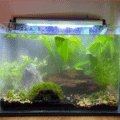
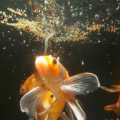


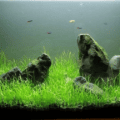

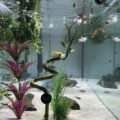
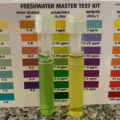
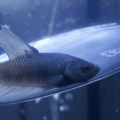
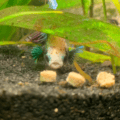
Hi, I have a 1,200 litre above ground, round poly- something tank (outdoors, inside a shade-house) with 6 goldfish ranging from 6cm (the surviving baby) to 22cm approx – they are all very active and seem quite healthy even though, while the ammonia is at 0.0, the nitrite is approx 5ppm and nitrate 40ppm! I’ve added lots of bottled bacteria and 5 times the Prime recommended amount after I did a 50% water change 2 weeks ago and a 30% water change one week ago. How long will it take to go through the Nitrogen Cycle in a 1,200 litre tank? I have water lilies and grass type plants – not really much algae – just a greenish tinge on the sun side of some rocks. I’m not sure what I’m doing wrong, or is it natural for this nitrite/nitrate spike – because when I introduced the fish after 2 weeks – the readings were all perfect. Thanks for any advice.
Hi,
I have been trying to start a small aquarium for awhile now. But my fish keep dying. (ugh so sad) I have done a lot of reading and research on what I need to do. I have a pretty small aquarium to start with. Its about 5 gallons. I have tried using API quick start and also Seachem Prime Conditioner. Each time I have tried these I have had fish die. I then thought maybe my fish needed more oxygen so I bought a bubbler and tried again. Fish died AGAIN. So THEN, I bought API freshwater master kit and started over last night. I tested everything before I put in any conditioner to see what chemicals are in my water. Everything was normal except my nitrite levels. It was reading at 30-40. No ammonia was present. I don’t know where to go from here I guess. I am assuming my fish are getting nitrite poisoning, as thats all I can think of at this point. I don’t want to get more fish until I figure this out. Any suggestions would be lovely!
Thanks!
Hi Lexi,
Thanks for explaining your situation in detail. I have a few questions and assumptions though, so let me know your thoughts.
First of all, the smaller the tank is – the more difficult it would be to keep the water stable… Unfortunately, smaller tanks are actually harder to maintain than larger ones, because having more gallons gives you room for error in the water parameters, so to speak.
Anyhow, I’m assuming you’re either putting too many fish at once, or you’re not using the bottled bacteria correctly (in conjunction with Prime, that is).
Have you read my post about bottled bacteria and how to use them? Here it is for your reference: https://aquanswers.com/api-quick-start-vs-tetra-safestart-work/
It lays out the method to do a fish-in cycle without exposing your fish to risk.
As to your current water readings – having a lot of Nitrites means that the tank is in the middle of the cycle and is not ready yet.
It’s good that you started measuring the water – that’s a must. Are you doing a fishless cycling currently?
Best,
Momchil
Hi I have a 90 gallon tank and 8 fancy orandas that I had to take out because I’m new to this and of course, Petsmart told me nothing about the whole Amonia and Nitrites Cycle UUUGGGHH! I already lost one of my favorite fish I’m devastated about and I don’t have an established tank so I basically have them all crammed into a 2.5 gallon tank that I’ve been changing everyday!! I’m going to go get a 10 gallon today because it’s obviously way too small! But I do need it small enough to change daily until their tank is established. So anyway, their tank is past the ammonia spike and has been for a week now and I’m at 20ppm of Nitrites…should I still do the 30% water change with my fish out of the tank and add the tetra or should I just add the tetra? I was told changing the water is only going to make the process take longer and I REALLY need this process to speed the hell up for my poor crowded fishes 🤦🏻♀️
Hi,
Just add the bottle.
…Are you sure it says 20 ppm and not 2 ppm? That’s quite high…
Hi, I have a 10g tank with 2 fantail goldfish with a nitrite level of 3. I noticed labored breathing in my fish and tested the water. I did a 30% water change, 3ml of seacham prime, 3 teaspoons of aquarium salt, and added 1 Aqueon Pure enzyme & bacteria ball. I don’t have any plants in the tank and it’s a fairly new tank. What else can I do to help cycle the tank? Would the liquid bacteria you recommend help? I’m nervous to add plants, the last one had ich and I lost fish and had to start all over.
Hi, Mindy,
Yes, the liquid bacteria will help a lot. It’s your safest bet if you want to help the cycle starting. Get a small bottle and pour it all in (ignore the recommended dose).
Other than that, you did pretty much all there is to be done in this situation, which means you did your research. Well done! The salt should help alleviate some of the stress put on your pet fish.
Sorry to hear about that Ich incident…
Feel free to reach out any time you need more answers.
Best,
Momchil
I have two established salt water tanks. They have been running for 5 years. About a month ago, I did a total clean up, (Filters, Bio plastic part) Vaccumed, Did a water change, and replaced the lives rocks with dead ones, (I had a large case of Aiptasia, and wanted to get rid of them, they were coming out of the live rocks( BAD MISTAKE! So for the last 4 weeks, I’ve been getting .25ppm of Nitrites, -0- Nitrates -0- Ammonia, Ph is 8.2. I try not to do too many water changes,(dont’ want to halt the Cycle from finishing) since then, I just changed my filters, one at a time, but did not wash off the Bio part, (just rinsed it with the same tank water and put it back. I’ve also been putting in Microbe-Lift Nite-Out II (Starter Bacteria) every day.
My fish seems fine, and are eating and doesn’t act like they are sick. My question is…..?? Why is the reading stuck on .25ppm of Nitrites, and not going down? Should I do some water changes beside adding the Starter Bacteria? And it seems to me like the cycle is almost done. But Am I doing enough? Should I do larger water changes, But still keep adding the Starter Bacteria? I’ve never been this stumped before with this issue. and I’ve had salt water fish for 25 years. Any advice on what to do?
Hi, from a cycling point of view, I’d say it’d better to do fewer water changes and keep adding bacteria.
However, with saltwater fish you want to avoid ammonia spikes. Nitrite is not that harmful to marine fish (as described in the article).
Do not worry, and wait out the cycling process by adding bacteria until you have normal water parameters. Your fish should be fine.
Best,
Momchil
First want to thank you for the article great info.
I believe I over cleaned my filter media trying to get a crystal clear tank and I am paying for it know. I have 5 guppies and a dwarf crawfish. The guppies are at top of tank and crawfish is searching for a way out. The test strips say I am at 3.0 to 5.0 of nitrite. My nitrate levels are okay. Got a liquid test for nitrates and it is in the40s. The nitrite test has not come in. I have plants in tank and have done water changes but the nitrite level will not go down. I had a algae bloom and had to use algae control that is when the guppies started going to the top of tank. Any advice would be appreciated.
Hi and thank you for your kind words!
So, the only really effective solution I see is to add bottled bacteria to the tank. A whole bottle of Tetra SafeStart+ should likely do it. Salt I wouldn’t add, because of your crayfish.
May I ask what kind of algae control you used before the issues started?
Regards,
Momchil
P.S. – if crystal clear water was your goal, you could use a pad of filter floss and stuff it in your filter’s cartridge.
I used tetra algae control, and it got rid of the algae. It all started with a huge bacteria bloom. I did add a bottle of tetra safe start on Wednesday I think. I shook it and it still had white bits. How long does it take to kick in. I have been doing water changes and the nitrite level is down to stress according to the strips. Still waiting for my test tube nitrite test kit. I even stuck a lucky bamboo in the tank and have ordered some floating plants. The fish seem a bit better. I know there is no instant fix, but would love one.
Hi again,
Bottled bacteria usually takes up to 2 weeks to completely re-establish the nitrogen cycle in an aquarium. It’s the fastest method known to do so, alongside adding substrate/filter media from another established tank.
If it all started with cloudy water, then it’s almost certain it was a nitrogen cycle crash.
How are your fishes?
The algae eaters are getting back to normal and the crayfish is no longer trying to escape. The guppies are a mixed batch, three seem to be doing better and two are still stressed. I may keep doing the water changes that seems t help lower it and until the bacteria is re-established.
That’s great to hear!
I’m happy to have helped.
I would also like to ask for a recommendation on a fish to help the dwarf crayfish keep the bottom clean. I have two small algae eaters and was thinking of getting a cory cat. I don’t want to get more then ten fish and crustation for my tank. It is a 20 gallon. Also I am keeping the fish in there all about the same size.
Thanks again.
Dwarf crayfish are opportunistic predators and may pray on anything that dwells at the bottom and is not large enough to fend for itself. So the best you could do is add a lot of shrimp (enough to maintain their population despite the occasional losses). However, this would mean breaking your own rule of not getting more than 10 denizens. I’d recommend getting at least 10 shrimp! Crayfish are slow and clumsy and shrimp are pretty agile.
Nevertheless, I’m assuming that your small fish may eat the shrimp babies anyway (unless your tank is heavily planted with a LOT of hiding places).
Bottom-dwelling fish will get bothered by the crayfish during the night. If you get a fish, at first, you may see a cut fin or two, which can lead to disease and weakness, and eventually death.
I know this may not be what you wanted to hear, but it is the case, in my experience and observations.
Best,
Momchil
The reson I did the ten rule is I don’t want to be someone that over populates there tank and then has trouble. (Of course I am having trouble) I have looked into the shrimp and a lot of sites say that not all do well with crayfish even dwarf crayfish. I think I read that cherry shrimp would do okay with him.
Thanks again for the help.
Yes, there will be shrimp losses no matter what. Crayfish are cool but can be massive … sometimes.
Good luck with your tank, you seem a responsible fish keeper!
Hopefully you read this, it’s been opinion after opinion from friends and reading articles and articles… I’ll try and break situation down easy as possible for you to PLEASE help….
It’s Oct 4th bought a 60g tank setup, bought a ONE fluval filter and heater, air bubbler, fake plants and centerpieces as for in the tank….
2-1/2 weeks in Oscar and dwarf…. Kept the dwarf returned the Oscars would’ve eventually been too big and first time mistakes….. Then had two Beta’s one died less than 10 hours returned it back to the store they even claimed could’ve been their water changes. then went and purchased two Dalmatian mollies four days later, then the seventh daythree dwarf had a chunk of his body missing (could see three flesh) isolated him bought the API curing formula and put him in a smaller tank… Three hours later he died! Even though They were all fine…
Then I let 4 days go by and five days ago bought 5 male guppies watched the Beta for aggressiveness etc they all coexisted fine ¯_(ツ)_/¯
3 days so three Beta was dying Watching him go to the surface for air cleaning on took them out put them in a separate tank with room temperature spring water he ended up passing away in the separate tank now I’ve done pretty much all the mistakes you said overfed too many efficient ones there’s no life plans it’s all fake?? So my water strip says that I have
Nitrates at 0-20
Nitrites at @5
Ammonia at 0
pH at 6-7
I did one water change this whole time just three days ago 30% mixed advice on adding API Quickstart some said you don’t need it I kept adding it in every week when introducing the fish and the first two weeks without having fish in it now I’m at a loss considering reading what you’ve told me I’m under the assumption I do need to keep adding API Quickstart and possibly from another person‘s inquiry similar situation adding floating plants and those plant balls??
I tried breaking EVERYTHING down as easy and fast to comprehend as needed?
Please let me know what I NEED TO DO?
THANKS IN ADVANCE!
Hi,
From your story, I can see that you’re adding too many fish at once, which leads to ammonia and nitrite spikes, because the tank is not cycled yet.
You need to add fewer fish along with some bottled bacteria and wait until the water parameters are a STABLE 0 ammonia, 0 nitrite, and 5-20 nitrate. After that – you can add another batch of fish.
Live plants help immensely, so get those if you can. Floating plants are an excellent option, because they keep the water pristine and suck up the excess nitrogen (again, ammonia, nitrite, nitrate).
Hope this helps.
Momchil
Hi I am having problem with high Ammonia,High Nitrite and a bit high Nitrate lately,and because I am so new on this so I am not really sure what should I do to help my fishes,so I try to look online and your page came across for my answer
You recently added too many fish at once. yes
You recently started the aquarium (less than a month and a half ago).yes
You did a full-clean of the filters and substrate or changed them.-yes
You feed your fish more than twice a day.-yes
…so if I already made mistake by already by adding too many fishes at once and now they become over population in my tank so how can I solve the problem as I dont want to give my fishes away if I dont have to ?
I can cut down to try feed them one a day in morning only if it would help
and if I try to add more live plants like duckweeds or Marimo moss ball..would they help some of my problem ( I have a few plans in my tank that I just add and grow them)
thank you
Hi Daisy,
First off, it’s nice that you’re reading and trying to improve. You’re actually on the right track with the solutions.
Indeed, I would recommend adding some floating plants and cutting down on feeding. Floating plants have access to atmospheric CO2 which speeds up their potential to suck excessive Nitrogen-based compounds from the water tremendously. No underwater plant will be better than a floater at that. Ammonia, Nitrite and Nitrate are all Nitrogen-based compounds.
Another thing I’d recommend is adding bottled bacteria to kick-start the Nitrogen Cycle properly. These bacteria will convert the Ammonia and Nitrite to Nitrate, which will then be used by the aquatic plants. Bottled bacteria are your best course of action for handling the issue on short notice (2 weeks at most).
Combining the three methods above will produce the best results, with bottled bacteria having the most impact for the time being. My choice for beneficial bacteria starter would be Tetra’s SafeStart Plus (there’s a link in the article to that).
Overstocked aquariums CAN work provided there are enough live plants (preferably floating ones) and a stable Nitrogen cycle (established colonies of beneficial bacteria).
Hope this helps.
Keep me posted on your course of action. 🙂
hey, is this comment section still open for answers? I will ask my question anyway and hopefully get an answer.
My question is- I have been cycling a 190 litre tank. I have really low ammonia levels, really high nitrites and really high nitrates. What does this mean? Am I cycled? How do i reduce my nitrites? I have been doing water changes and the nitrites and nitrates dont seem to be lowering much… the nitrates lowered a little after the last water change but the nitrites are still really high.
I’m confused and can’t seem to find the answer online.
Thanks 😊
Hey Gem,
Firstly, the aquarium is not cycled unless ammonia and nitrItes are down to 0.
Secondly, don’t do water changes while cycling! Let the bacteria handle the Nitrite and Ammonia. The bacterial colony will grow proportionally to the available resources.
Changing water removes some of these resources that would otherwise build up naturally.
When the fish tank has cycled you can perform water changes.
Essentially water changes are performed to export NitrAtes because they stay in the system unless used up by some fast-growing aquarium plants such as most floating ones (I have an article on those if you’re interested – just use the search bar).
Cycling usually takes a relatively long time (sometimes more than a month). You could speed it up by using some bottled beneficial bacteria, but I’m sure you already know that if you’ve read my article. 🙂
Hope this helps, feel free to ask more questions if you will. The Comment Section is indefinitely open (at least that’s the plan for now).
Regards,
Momchil